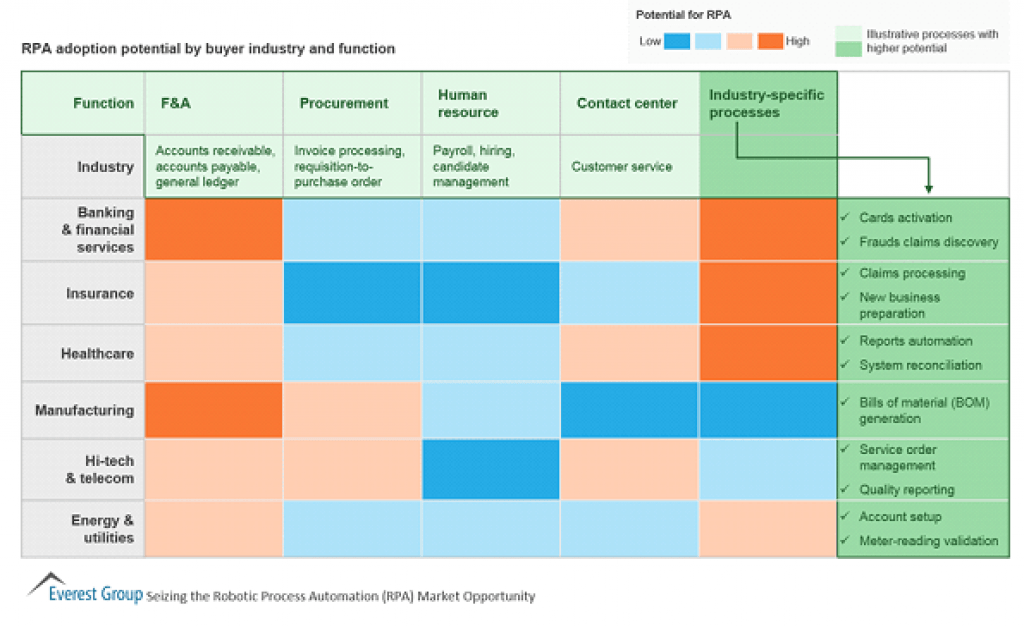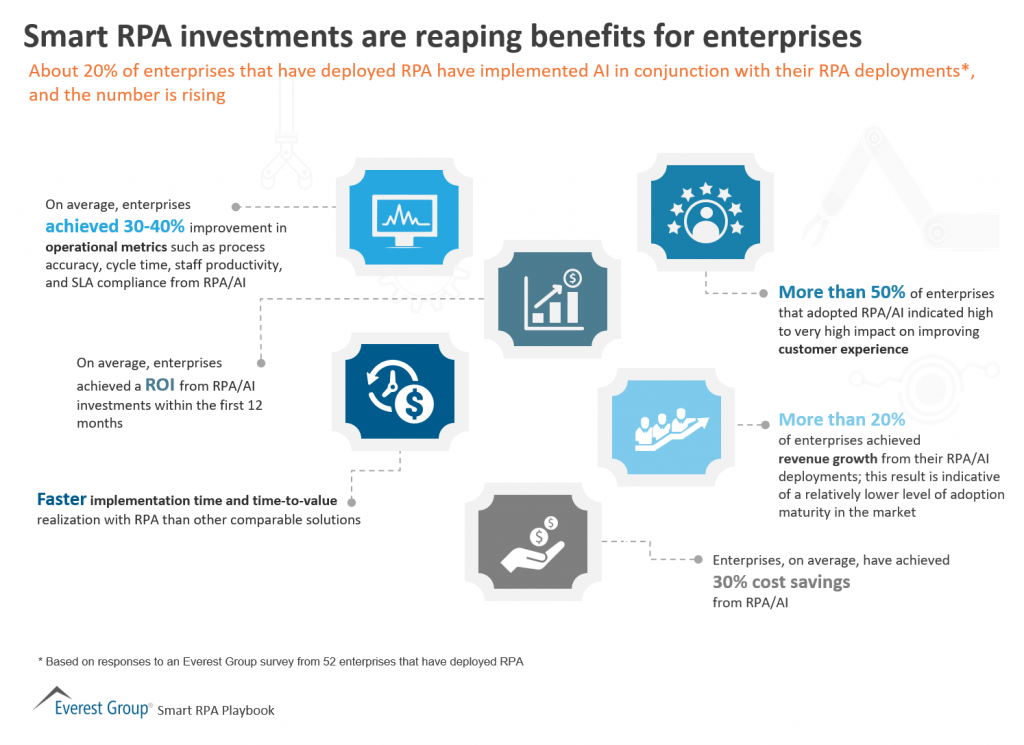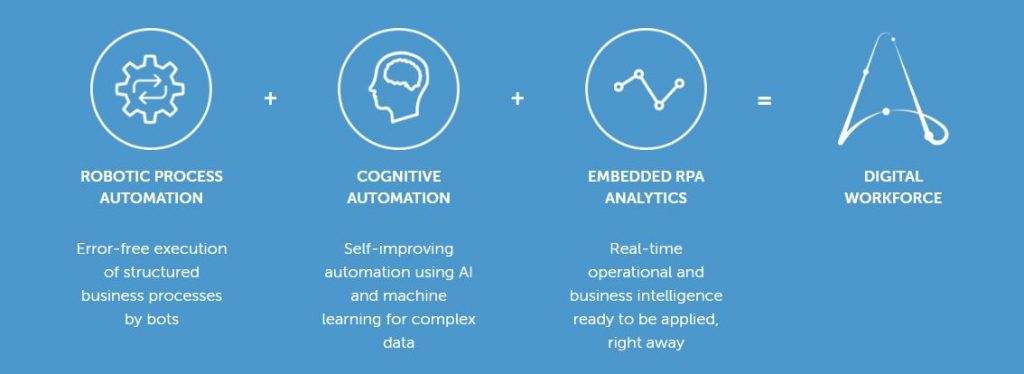
They’re all around us. Emotionless workers performing the same actions over and over again. All-day, every day from the moment they start work. They just go through the motions they’ve been trained to do based on procedures the company has defined.
There isn’t much thought that goes into the tasks since it’s all effectively pre-programmed from day one.
Over time, they may make small modifications to the actions or steps performed through process improvement initiatives, but not much changes year over year.
There is also limited opportunity to learn new skills and grow to take on a new role. The worker is effectively given a single job and the expectation is they continue doing that job well into the future.
While this may sound like the work-life of a robot, this is actually a description of millions of human employees across the country right now. This highlights the risk repetitive, low complexity jobs face when technology such as robotic process automation (RPA) hits the mainstream.
The exciting and scary thing is that it’s already happening.
According to an RPA study by Deloitte, over 50% of companies have already started to evaluate and deploy robotic process automation technology within their company.
Since RPA technology has the potential to completely shift the foundation of a company, most start small. This can include evaluating and applying automation capabilities as part of a low-risk pilot function or process.
In short, robotic process automation is growing at a rapid because companies see the unmatched quality improvement and cost savings that robots can provide.
This is true across nearly all industries and almost every business function; including finance, human resources, information technology (IT), operations, customer service, and marketing.
If your job is at-risk due to RPA now or could be in the future, you have the ability to make yourself indispensable by understanding the technology. Even if it’s not, right now is when you should start building your knowledge of this fast-growing, high demand technology.
We want to help you along this journey. We’ll start with an overview of what robotic process automation is, where it is being applied, and ultimately guide you to resources to build your RPA expertise.
What is Robotic Process Automation?
Robotic process automation, also referred to as RPA, is a type of technology that enables humans to program or configure computer-driven “robots” to mimic actions humans typically perform. When triggered, these robots are capable of extracting data from systems, entering information, making selections in applications, or performing physical actions when connected to machinery.
Just to be clear, these robots can be either physical machines that can work on a factory assembly line or software that runs on computers. The term that’s been widely used to describe these robots is digital workforce.
RPA allows companies to take human elements, like errors or distraction, out of processes that are repetitive, standardized, and low in complexity. We’ve all keyed teh wrong letters or numbers at some point in our lives due to a disconnect between our brain and fingers while typing. Robots don’t have this problem.
Robots are still prone to “bad data in, bad data out” issues, but they are much more accurate than humans at performing many tasks at high volumes. In fact, according to Deloitte, over 90% of companies saw an improvement in quality and compliance as a result of RPA.
On top of all this, robots effectively work 24 hours a day / 7 days a week at a cost substantially lower than human employees. How can companies pass on that deal?
How does Robotic Process Automation work?
In general, robotic process automation involves three components; trigger, processing, and output.
- The trigger is an action such as the push of a button, opening of a specific application, or a sensor waiting for an action.
- The processing includes a specific sequence of automated steps the robot takes.
- Finally, the output is the business result of automated processing.
Examples of outputs can often include logging users into systems, copying and pasting data between systems, and scraping/extracting information from applications.
With industrial robotic applications, this can involve welding of parts, bolting of objects together, or drilling holes in a material.
What processes are candidates for RPA?
Think of a simple task you repeatedly do every single day. There’s a good chance that task, no matter what it is, can be automated using RPA.
Most companies start their RPA journey by applying the technology to back-office processes such as finance, HR, and operations.
Think about the routine processing that accountants typically perform to ensure numbers even out on balance sheets. The process to find irregularities and the steps taken to report and correct issues are pretty standardized, right? (Hint: it’s federally regulated)
Or take an example from operations. Maybe you have a data entry team that is responsible for entering orders or resolving data issues. In most cases, the data is pretty well defined and there are frequently the same issues that show up.
It doesn’t take a significant amount of effort to define rules and actions that can be applied when triggered by certain events.
However, marketing and customer service are prime candidates as well since many actions are repeatable across customers. This is where RPA technology is being deployed to automatically respond to customer questions via chat or automated voice systems.
Everest Group put together the heat map below which does an excellent job at identifying key areas with high RPA potential by industry and business function.

Essentially, automation makes sense for most repeatable, rule or logic-driven, high volume, and lower complexity business processes.
There’s a decent chance some of the work you do every day falls into this classification. Whether it’s copy/pasting information between applications or just logging into applications – there are RPA opportunities everywhere!
What are the benefits of RPA?
Robotic process automation will only become more prevalent in the future and adoption will grow exponentially. Why is this?
Leaders understand the incredible ROI of robots and automation capabilities for their business. They are able to take something that has historically been incredibly manual and turn it into something that requires no human interaction.
The value of RPA technologies is typically realized across five dimensions:
Given the short deployment period for robotic solutions, the lead time to realizing benefits can be remarkably short. In a lot of cases, you’ll start to see a return within the first year of implementation.

The benefits are even greater for larger organizations.
Example RPA Cost/Benefit Analysis
Let’s take an example company that employs 1,000 employees to support back-office operational functions. Each spends its days correcting data errors, inputting information, and copying data between systems with an average of 100 units processed per day.
Assume those users work 40 hours a week at $15 per hour and are working 260 days per year (~$31K annually). That’s over $31 million the company is paying each year to staff those positions to process 26 million units annually.
Now, say you deploy a team of 10 robots that can process 600 items each per day. You will need to spend money upfront to design, build, test, and deploy the robots initially. We’ll assume a cost of $50K per robot which makes the total investment $500K.
However, these robots are running about 360 days per year (assumes some downtime) without vacations or sleeping.
With these robots, you have workers that are twice as productive and work 3 times longer than a human employee. On an annual basis, this team of robots can process about 2 million units.
If they replaced every employee with a robot, they could process about 200 million units annually. This increased capacity and flexibility can be crucial for companies that are rapidly growing or experience peaks in processing demand each year.
To put this into perspective, for every 10 robots the company deploys, they can effectively cut the workforce by roughly 41 employees. This would give the company a net benefit of $771K, after accounting for the initial investment, in the first year alone by replacing those 41 workers.
These savings are likely on the lower end and benefits will vary depending on the business process and level of automation.
Why did we paint this picture? To show how extremely easy it is for companies to justify investment in RPA technology to replace or augment their workforce.
How fast is RPA growing?
In short, the growth of RPA in recent years has been huge. It’s expected that in the next couple of years, about 70% of companies will have invested in evaluating, prototyping, or deploying RPA technology. This number is roughly double what it was less than a decade ago.
In addition, Gartner reports that the RPA technology market in 2017 was around $518M – by 2020 the RPA market will be worth over $1B! That’s insane grow and shows how much companies are pouring into robotic capabilities.
On top of that, companies that have already begun to evaluate and deploy RPA are looking to increase investment and velocity of implementation. Leaders see the value RPA can bring and believe it’s a must-have technology if they want to continue to stay competitive in the future.
Will RPA take over your job?
Maybe. However, the majority of companies believe digital workforce technology is expected to assist or supplement the human workforce’s everyday processing, rather than completely taking over most jobs. Of course, some jobs are certainly at higher risk than others if they include more repetitive and simple tasks.
Think about all the news reports you’ve seen in the past about jobs being outsourced to other countries so companies could save costs. The good news is some of those jobs may come back domestically. The bad news is a good portion of those jobs are prime candidates for automation.
Imagine the headlines when companies start cutting thousands of jobs since they can get more work done with cheap robots. The rise of the digital workforce is quickly becoming a reality and has already started to replace jobs.
If you’re really concerned, you could listen to Elon Musk and other visionaries who think becoming a master of RPA and AI is the best way to secure your job for the long term. Rather than letting the technology take over your career, understand how it’s being applied to be seen as an early adopter and leader.
Building RPA expertise will have tremendous benefits for your career and may open up new opportunities down the road.
Robotic Process Automation Tools
There is an ever-growing list of vendors that are jumping into the robotic processing market to take advantage of the massive growth. The vendors that make up the top 10 in market share according to Gartner continue to shift right along with it.
While the market will continue to evolve, there are a few RPA tools that continue to dominate the top of the charts. It’s a safe bet that one of these has been tested and deployed at companies within your industry.
Top 5 RPA Tools
1. UiPath

Without question, UiPath is one of the most widely adopted RPA platforms globally. The user interface used to design and deploy robots is clean and super easy to use.
This is a great starting point whether you’re new or experienced with RPA technologies. They even have a completely free online training curriculum that can take you from newbie to an advanced user in a short period of time.

Key Features:
- Provides access to hundreds of customized and shareable robot activities
- Open integration architecture allows for connectivity to existing systems
- Rapid and scalable deployment of robots to provide flexibility
- Robots can learn AI skills to take automation one step further
2. Automation Anywhere

A close competitor to UiPath is Automation Anywhere. The two companies make up over 15% of the RPA market share in terms of robot deployments.
However, Automation Anywhere recently rolled out an entirely cloud-native platform for RPA which will rapidly increase adoption going forward. This could be a game-changer and the other vendors are following this trend as well.

Key Features:
- Intuitive user interface for designing automated processes
- Self-improving automation with AI
- Embeds analytics to track real-time operational performance
- Availability of a cloud-native RPA platform option
3. Blue Prism

Another popular RPA solution is Blue Prism. They lag behind UiPath and Automation Anywhere in deployments, but offer a product that’s more geared towards enterprise implementations.
Similar to other vendors, they have a very user-friendly interface that supports primarily drag-and-drop process design. This supports the needs of business areas that don’t have IT support that may be required for other solutions.

Key Features:
- Focuses on drag-and-drop process building with optional coding
- Capable of integrating with older and more advanced technologies
- Additional AI and robotic capabilities through their Digital Exchange app store
4. NICE Systems

NICE offers a workforce management suite of products that RPA complements nicely. While they are more traditional in how RPA is designed and deployed using servers and the desktop, the robots are highly effective.
Similar to other RPA products, the configuration of the robots is fairly simple. The system primarily records/captures user actions to instruct bots on what actions should be taken in the future.

Key Features:
- Deploys on back-end servers hosted by the company to coordinate bots deployed on staff desktops
- Paired with a separate Desktop Analytics product, it can use analytics to identify more automation opportunities
- Offer a virtual employee assistant called NEVA which can help automate mundane tasks
5. Pegasystems

Pega is most known for its business process and case management software platform. This solution allows businesses to track and manage work that their employees do on a day-to-day basis.
Combining this with Pega’s RPA capabilities, enterprise processes become extremely simple to manage and automate. What’s more, their robotic software can be deployed directly on user desktops to be readily available to assist when required.

Key Features:
- Broad support and integration with most legacy and current enterprise business systems
- Robotic Desktop Automation (RDA) product to provide flexible and fast deployment for business users
- Integrates with Pega’s enterprise business process management and case management platform
How to Get Certified in Robotic Process Automation (RPA)
In most cases, you can earn a certification directly through each of the vendors. Both UiPath and Automation Anywhere have free online programs to build your technical knowledge and earn certifications.
Earning an RPA certification will demonstrate your ability to understand and more importantly, apply RPA to business processes. The first step to certification is to take some highly-rated training.
Recommended RPA Training Courses
The following courses will help build your knowledge and expertise in RPA concepts and technologies. We start with a recommended introductory course and then jump into training for UiPath, one of the top RPA technologies.
UiPath – Level 2 Robotic Process Automation
This course will take the skills you learned in the UiPath Level 1 course, add some new, advanced skills, and lace them all together with enterprise best practices. In this project-based course, they cover all the topics you’ll need to be job-ready with UiPath RPA at any enterprise company.
Top RPA Jobs
While RPA may eliminate or completely change some jobs, it’s also creating new career paths. So, what jobs can you get with RPA training and certification?
RPA jobs can primarily be broken down into four roles: Business Process Analyst, Developer, QA / Tester, and Product Manager.
- RPA Business Process Analyst: Assess requirements and document the inputs, decision, and outputs of business processes planned to be automated through RPA.
- RPA Developer & Engineer: Design, code, and configure the triggers, business logic, and actions to be performed by the RPA robot.
- RPA Solution Architect: Creates the overarching solution to integrate RPA technology with other applications and data sources to carry out activities.
- RPA QA / Testing Engineer: Defines the test strategy and cases to ensure the robot is processing correctly and accurately.
- RPA Product Manager: Establish the RPA strategy, processes/governance, product roadmap, and delivery team for the company.
The Future: Combining RPA + AI
There is sometimes a misconception that robotic process automation is the same as artificial intelligence (AI) or machine learning. These are completely separate technologies, however, companies that combine RPA and AI technology solutions can enable new levels of productivity.
Most current and previous generations of robotic process automation (RPA) technology removed non-value add and repetitive work from employee’s responsibilities.
This frees them up to dedicate more energy to solving complex problems and adding value to the company or its customers. This includes removing basic data entry tasks, copy/pasting information between forms or screens, and retrieving timely customer information.
With future RPA technologies, it will be able to learn new skills and actions through the integration of AI and machine learning capabilities.
This will allow the robot to use AI to perform more complex and dynamic tasks that current robots are unable to do. This may include more precise interaction with systems, reading unstructured documents to extract data for processing, communicating with humans, and continuously optimizing processes.
The more advanced AI and robotic processing automation capabilities include:
1. Visual Understanding
Utilize visual recognition software to interact with user interfaces as a human does today. This can reduce the need to continuously feed data to the robots through APIs or other inputs. This enables the robot to maintain automation leveraging “sight” to understand what actions need to be performed rather than a constant data feed.
2. Document Understanding
Build a deeper understanding of structured and even unstructured documents to extract new information for processing. This involves scanning an unrestricted number of variations in document types and images that do not follow a template.
Think of all the different formats of receipts, invoices/bills, medical records, and other document types you’ve seen. It’s difficult for humans to find important data on the documents, but robots with AI can process them much faster.
3. Conversational Understanding
A major trend in AI in the past decade has been developing sentiment analysis and conversational reasoning. This capability allows the AI-powered robot to analyze text, voice, and chat inputs to determine what response is required or where to direct the human user.
Actions can include routing a call to the right area, finding and providing information, or executing requests for the user in the case of Alexa or Google Assistant. The conversational understanding of AI technology is progressing at an incredible pace. There will come a day when you won’t be able to tell if you’re interacting with a human or robot.
4. Process Understanding
This capability is all about the ability to observe how processes are executed and continuously apply learnings to make improvements. Companies can feed as-is process designs into the robot or have them observe humans so they can get started on completing process activities.
The robot then evaluates and identifies opportunities to improve the process based on the benefits it will provide. RPA robots would then be able to auto-configure changes to become more efficient over time.
Conclusion
Robotic process automation is growing at an incredible rate. There is undeniable evidence that companies see the value of adopting robots to take over tasks historically performed by humans. They’re focusing now on repetitive and low complexity tasks, but this will change as robots are able to learn skills through the use of AI.
Your job may not be in immediate danger of being replaced since the technology is still in the early phases. But why wait around for the inevitable?
To stay ahead of this workforce transformation, it’s recommended to at least understand what RPA is and where it can be applied. Even better, you should get certified in RPA to become a go-to resource for your company once they decide to begin investing in the technology. The day is coming – so prepare yourself and career for it!



